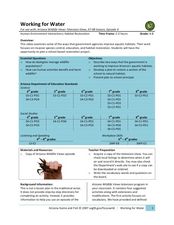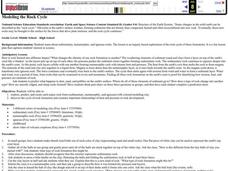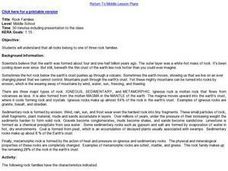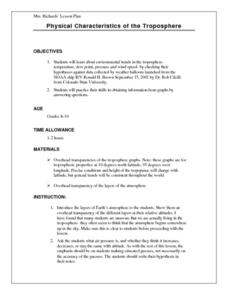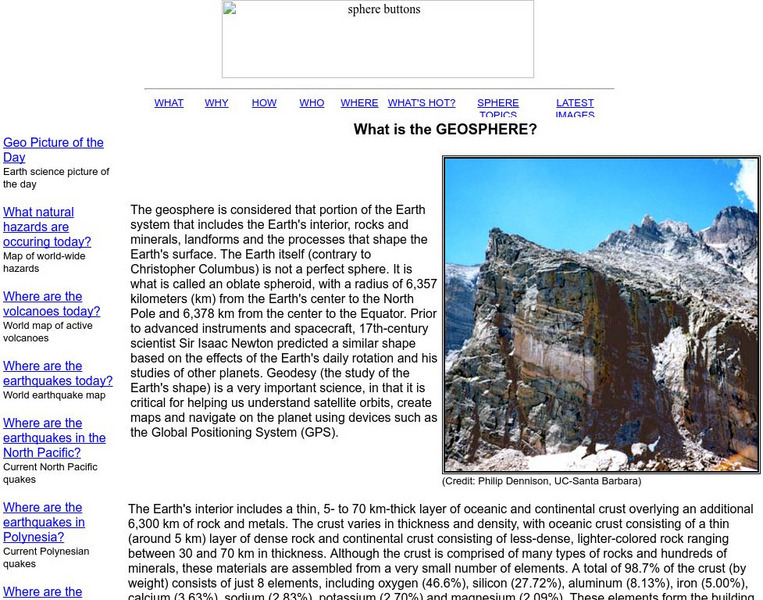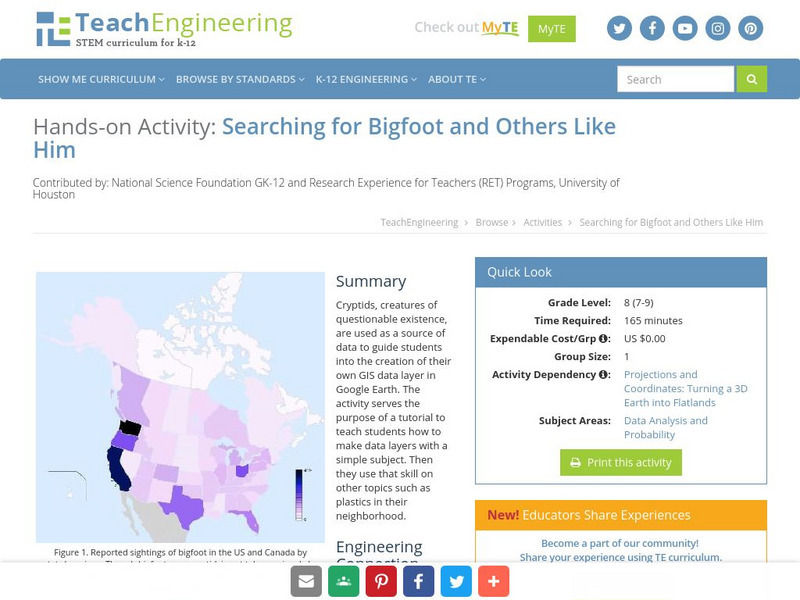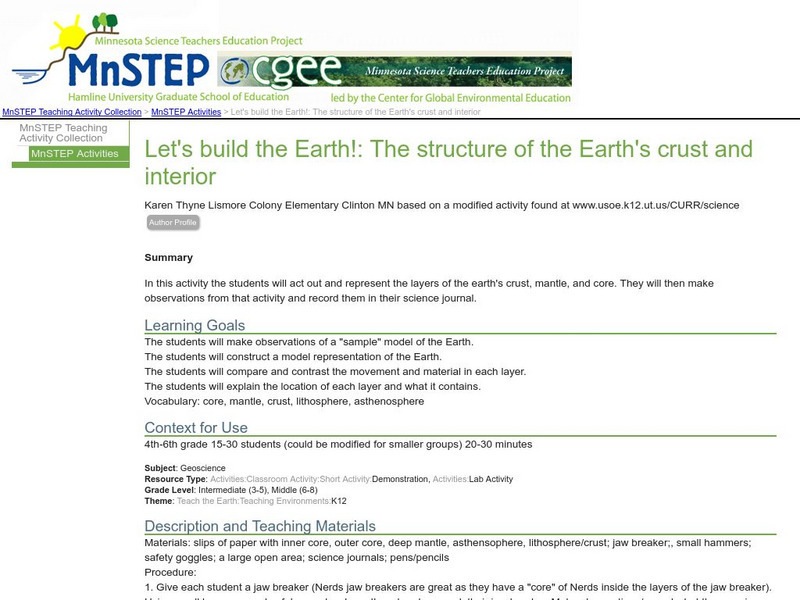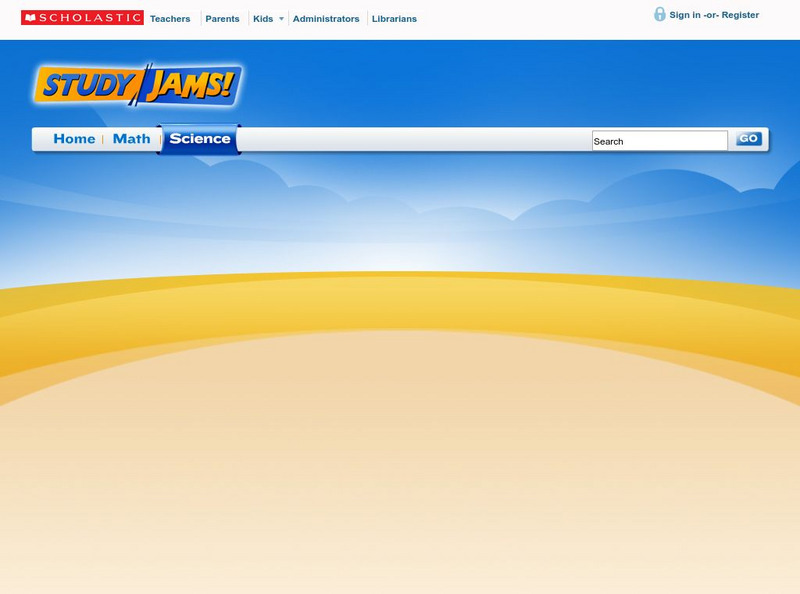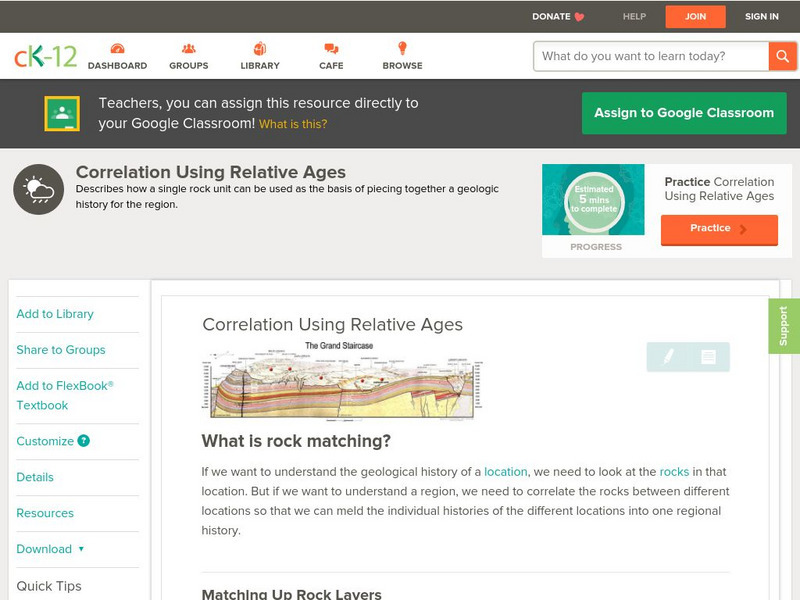Curated OER
Sediment Deposition Lab
Learners set up a stream table, observe erosion, and record data on where various sizes of sediments settle. They draw conclusions as to what kind of sedimentary rock form in what locations.
Curated OER
Working for Water
Students examine the ways that government works to help improve aquatic habitats. In this water habitats lesson students view a video and plan a school restoration project.
Curated OER
Erosion Patterns
Fifth graders explore erosion and the different types of sediment. In this erosion patterns instructional activity students complete an activity and divide into groups and conduct an experiment.
Curated OER
Particle Size and Oil Production
Students investigate how permeable different materials are. For this physics lesson, students determine what affects permeability and how permeability relates to oil production.
Curated OER
Modeling the Rock Cycle
Young scholars explore the differences in sedimentary, metamorphic, and igneous rocks. They discuss the rock cycle of the different formations. Students discuss how rock is formed into different shapes. They explore, predict, and create...
Curated OER
Rock Families
Students study the three types of rock characteristics; igneous, sedimentary, and metamorphic. They are divided into three groups and each group takes one of the rock characteristics. They then act out the characteristics of their rock...
Curated OER
Three-dimensional cooperative modeling
Students explore what is present below the surface in order to drill into the ground and record the type of material that the drill brings to the surface. They discuss the benefits and drawbacks of distance communications. Students...
Curated OER
Physical Characteristics of the Troposphere
Students lexplore environmental trends in the troposphere- temperature, dew point, pressure and wind speed- by checking their hypotheses against data collected by weather balloons.
Curated OER
Physical Characteristics of the Troposphere
Learners examine troposphere graphs and mcompare their hypotheses with data collected by weather balloons launched from the NOAA ship, Ronald H. Brown. they write summaries about the physical properties of the troposphere.
Curated OER
Cookie Bar Coal
Students observe the effect of heat and pressure on materials representing those involved in the formation of coal.
Curated OER
A DISAPPEARING ACT Astronomy: Do Stars Always Shine?
Learners observe why stars are not visible during the day with a classroom demonstration using an index card punched with holes.
Curated OER
Let's Get To the Core!
Students practice analyzing ice core samples to discover climate changes. Using the samples, they identify and graph the gas amounts. They use these numbers to determine their effect on global warming. In pairs, they complete a...
Curated OER
Craters!
Eighth graders examine the formation of craters. For this craters lesson, 8th graders discover the various energies involved in the formation of a crater, where you can find a crater in the Solar System, and observations of craters on...
Curated OER
Creating Journals
Students take a virtual tour of Yosemite and selects photographs to use in their journal.
Curated OER
The Sun
For this space science worksheet, students learn 4 facts about the sun. Students also read a short passage about the sun to gain more information.
Curated OER
What Lies Beneath the Upper Crust?
Students discover if information in an article is accurate and current. In this science lesson, students read the story carefully and decide on what the subject of the article is. Students search the Internet to see more information...
Utah Education Network
Uen: Nhmu: Our Ancient Earth the Stratigraphy Cup
Activity provides students an opportunity to make a stratigraphy cup.
Rice University
Museums Teaching Planet Earth: What Is the Geosphere?
Describes Earth's layers, which make up the geosphere.
American Museum of Natural History
American Museum of Natural History: O Logy: Stuff to Do: Edible Earth
Take a look at the layers that make up our Earth: inner core, outer core, mantle, and crust. Then have fun making a model of the Earth's interior that you can eat up.
TeachEngineering
Teach Engineering: Searching for Bigfoot and Others Like Him
Cryptids, creatures of questionable existence, are used as a source of data to guide students into the creation of their own GIS data layer in Google Earth. The activity serves the purpose of a tutorial to teach students how to make data...
Science Education Resource Center at Carleton College
Serc: Let's Build the Earth!: The Structure of the Earth's Crust and Interior
For this activity, students will make observations then construct a "sample" model representation of the Earth's layers. They will compare and contrast the movement and material in each layer explaining the location and what it contains.
Scholastic
Scholastic: Study Jams! Science: Weather & Climate: Earth's Atmosphere
A video and a short multiple-choice quiz on the composition of and the layers in Earth's atmosphere.
CK-12 Foundation
Ck 12: Earth Science: Correlation Using Relative Ages
[Free Registration/Login may be required to access all resource tools.] How rock layers in different locations can be connected to make pictures of a region's geology.
CK-12 Foundation
Ck 12: Earth Science: Correlation Using Relative Ages
[Free Registration/Login may be required to access all resource tools.] How rock layers in different locations can be connected to make pictures of a region's geology.

